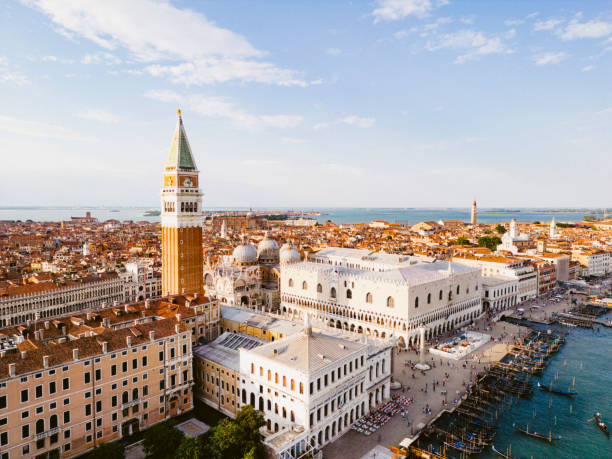The journey from Cairo to Venice, as captured by Mahmood Nizami in his travelogue, stands as a hallmark in Urdu literature. Written in 1952 under the UNESCO initiative, Nizami’s account of this voyage combines cultural reflections, historical insights, and literary finesse, making it a cherished piece of travel writing.
A Modern Take on Urdu Travel Writing
Mahmood Nizami’s narrative about his journey from Cairo to Venice introduced a fresh perspective in Urdu travelogues. Before “Nazarnama,” travel writing in Urdu predominantly focused on dry factual reporting. Nizami, however, enriched his account with vivid emotions, imaginative descriptions, and cultural observations, setting a new precedent for the genre.
The Cairo to Venice Journey
The journey from Cairo to Venice formed one of the key chapters in Nizami’s travelogue. Boarding a plane from Cairo, Nizami described the breathtaking aerial views, painting a picturesque image of the landscapes below. His narrative not only documented the geographical transition but also reflected the anticipation and excitement of entering Europe.
A Cultural and Historical Tapestry
Upon arriving in Venice, Nizami immersed himself in the city’s unique culture and rich history. From the enchanting canals and gondolas to the architectural marvels, he captured the essence of Venice with a literary charm that transcended mere factual recounting. Nizami’s reflections highlighted the timeless beauty of Venice while drawing connections to its historical and cultural significance.
A Blend of Fact and Emotion
Unlike traditional travelogues, Mahmood Nizami’s journey from Cairo to Venice is an amalgamation of factual precision and emotional depth. His vivid imagination and artistic flair never overshadow the authenticity of his narrative. This balance allows readers to engage with the text on both intellectual and emotional levels.
Venice: A Timeless City
Nizami’s portrayal of Venice goes beyond its physical beauty. He explored the city’s cultural heartbeat, delving into its art, traditions, and societal nuances. His observations provide a multidimensional view of Venice, making it come alive for readers as more than just a destination—but as an experience.

Pioneering a Literary Tradition
Mahmood Nizami’s travelogue, particularly the chapter detailing his journey from Cairo to Venice, stands as a pioneering work in Urdu literature. By combining historical insights, personal reflections, and literary aesthetics, he created a timeless narrative that continues to inspire readers and writers alike.
Conclusion
The journey from Cairo to Venice, as documented by Mahmood Nizami, remains a cornerstone of Urdu travel literature. It represents a harmonious blend of history, culture, and personal narrative, offering a vivid window into a bygone era. For those seeking a literary exploration of Venice through the lens of an Urdu travel writer, this account is a must-read.
If you’re interested in reading this book, click the link below for a free download.
https://drive.google.com/file/d/1XbmES-bfXhVTq1nAcAyEfLB0wMMS6iLC/view?usp=sharing
If you’d like to listen to this book in audio format, click the CONTACT button below to get in touch with the AwazeUrdu team to order the audiobook.
Contact us:Click the link below to watch the video on Febspot as well.
https://www.febspot.com/video/2553888
Click the link below to watch the video on Rumble as
well.https://rumble.com/v5tpk2t-journey-through-cairo-to-rome.html
Click the link below to watch the video on Facebook as well.
https://www.facebook.com/share/v/12AVd1EwCox
محمودنظامی مرحوم کاسفرنامہءیورپ وامریکہ اردوکےاولین سفرناموں میں سے ہے۔ 1952ء میں اقوامِ متحدہ کےادارے یونیسکو کےزیرانتظام ان کاسفر ان ممالک میں ہوا۔ انہوں نےاپنےتاثرات مضامین کی شکل میں قلمبند کئے ہیں۔ انہی مضامین کامجموعہ بعد میں “نظرنامہ” کےنام سےشائع ہوا۔
یہ کتاب مصنف کی ذاتی آراء اور یادوں مشتمل ہے۔ ہم اسے اردوکےجدید سفرنامےکی بنیاد کہہ سکتے ہیں کہ اس میں جذبات کی آمیزش کےساتھ ادبی چاشنی بھی موجود ہے۔ ان کاتخیل بلند ہےمگرکہیں بھی انہوں نےحقائق نگاری سے بھی پہلوتہی نہیں کی۔ وہ جن شہروں سے گزرے وہاں کی تہذیب اور ثقافت کو بھی نمایاں کیا۔
آوازِاردو سفرنامہ سیریزکی اس ویڈیومیں اس کتاب کے ایک مضمون “روم نامچہ” سے اقتباس پڑھاگیاہے۔ جب وہ بذریعہ ہوائی جہاز قاہرہ سے روم کےلئے روانہ ہوئے توجہازسےنظروالےمناظرکی منظرکشی کےعلاوہ انہوں نے شہرِوینس اورروم کی تاریخ وتہذیب بھی بیان کی ہے۔ یہ عنوان شہرِ روم اورروزنامچہ کوملاکر بنایاگیاہے۔ یعنی ایسی تحریر، جس میں روم میں گزارے گئے شب وروز کااحوال ہو۔ “نظرنامہ”سے پہلےعموماًسفرنامے میں روکھے پھیکےاندازمیں صرف حقائق بیان کئے جاتے تھے،مگر اس کتاب میں تخیل،جذبات اورتاثرات کی آمیزش نےاسےسفرنامےسےزیادہ ایک ادبی فن پارہ بنادیاہے

